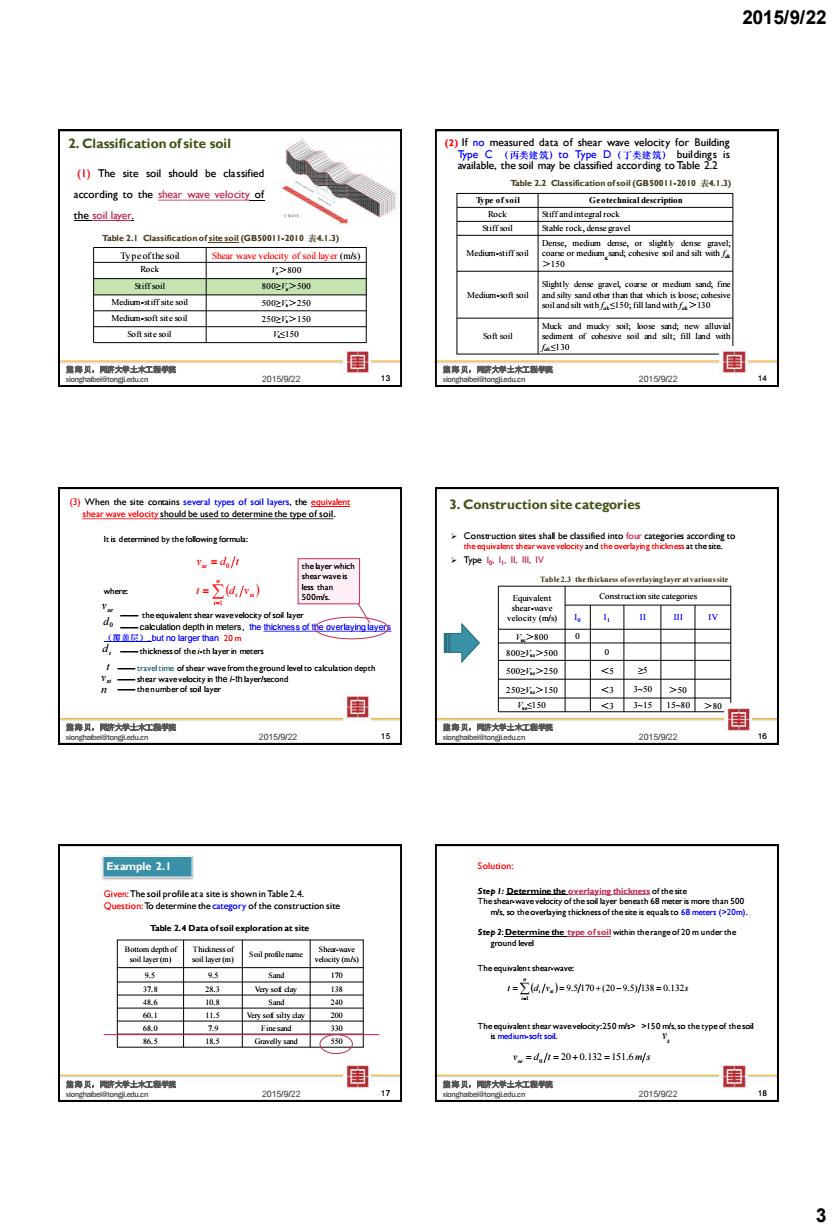正在加载图片...

2015/9/22 2.Classification ofsite soil m (The site soi should be cassifiec rding to the shear wave velocity of e 2.I Cla o(C850011-2010表413 Medu-tiffd >25 3.Constructionsitecategories ▣d/月 bdoy 2。 0e5>25055 ⊙ Example 2.1 8a2 二m Th V=d./=20+0.l32=1515mh2015/9/22 3 (1) The site soil should be classified according to the shear wave velocity of the soil layer. 2. Classification of site soil Type of the soil Shear wave velocity of soil layer (m/s) Rock Vs>800 Stiff soil 800≥Vs>500 Medium-stiff site soil 500≥Vs>250 Medium-soft site soil 250≥Vs>150 Soft site soil Vs≤150 Table 2.1 Classification of site soil (GB50011-2010 表4.1.3) 2015/9/22 熊海贝,同济大学土木工程学院 xionghaibei@tongji.edu.cn 13 (2) If no measured data of shear wave velocity for Building Type C (丙类建筑)to Type D(丁类建筑) buildings is available, the soil may be classified according to Table 2.2 Type of soil Geotechnical description Rock Stiff and integral rock Stiff soil Stable rock, dense gravel Medium-stiff soil Dense, medium dense, or slightly dense gravel; coarse or medium sand; cohesive soil and silt with fak >150 Medium-soft soil Slightly dense gravel, coarse or medium sand; fine and silty sand other than that which is loose; cohesive soil and silt with fak≤150; fill landwith fak>130 Soft soil Muck and mucky soil; loose sand; new alluvial sediment of cohesive soil and silt; fill land with fak≤130 Table 2.2 Classification of soil (GB50011-2010 表4.1.3) 2015/9/22 熊海贝,同济大学土木工程学院 xionghaibei@tongji.edu.cn 14 (3) When the site contains several types of soil layers, the equivalent shear wave velocity should be used to determine the type of soil. It is determined by the following formula: v d t se 0 n i i si t d v 1 where: —— the equivalent shear wave velocity of soil layer —— calculation depth in meters, the thickness of the overlaying layers (覆盖层), but no larger than 20 m —— thickness of the i-th layer in meters se v 0 d di —— travel time of shear wave from the ground level to calculation depth —— shear wave velocity in the i-th layer/second —— the number of soil layer t si v n the layer which shear wave is less than 500m/s. 2015/9/22 熊海贝,同济大学土木工程学院 xionghaibei@tongji.edu.cn 15 3. Construction site categories Construction sites shall be classified into four categories according to the equivalent shear wave velocity and the overlaying thickness at the site. Type I0, I1, II, III, IV Equivalent shear-wave velocity (m/s) Construction site categories I0 I1 II III IV Vse>800 0 800≥Vse>500 0 500≥Vse>250 <5 ≥5 250≥Vse>150 <3 3~50 >50 Vse≤150 <3 3~15 15~80 >80 Table 2.3 the thickness of overlaying layer at various site 2015/9/22 熊海贝,同济大学土木工程学院 xionghaibei@tongji.edu.cn 16 Given:The soil profile at a site is shown in Table 2.4. Question:To determine the category of the construction site Example 2.1 Bottom depth of soil layer (m) Thickness of soil layer (m) Soil profile name Shear-wave velocity (m/s) 9.5 9.5 Sand 170 37.8 28.3 Very soft clay 138 48.6 10.8 Sand 240 60.1 11.5 Very soft silty clay 200 68.0 7.9 Fine sand 330 86.5 18.5 Gravelly sand 550 Table 2.4 Data of soil exploration at site 2015/9/22 熊海贝,同济大学土木工程学院 xionghaibei@tongji.edu.cn 17 Step 1: Determine the overlaying thickness of the site The shear-wave velocity of the soil layer beneath 68 meter is more than 500 m/s, so the overlaying thickness of the site is equals to 68 meters (>20m). Step 2: Determine the type of soil within the range of 20 m under the ground level The equivalent shear-wave: The equivalent shear wave velocity: 250 m/s> >150 m/s, so the type of the soil is medium-soft soil. Solution: t d v s n i i si 9.5 170 (20 9.5) 138 0.132 1 v d t m s se 0 20 0.132 151.6 s v 2015/9/22 熊海贝,同济大学土木工程学院 xionghaibei@tongji.edu.cn 18